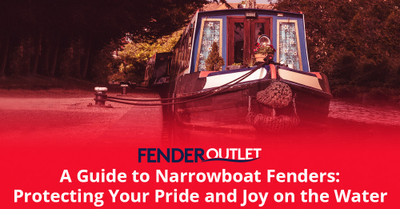26th Aug 2025
When you’re cruising the UK’s canals and rivers, your narrowboat isn’t just a vessel - it’s often your home, your holiday retreat, and your pride and joy. With so much time and care invested, it makes sense to protect it from knocks, scrapes, and impact damage. That’s where narrowboat fenders come in.
What Do Narrowboat Fenders Do?
Narrowboat fenders act as a cushion between your boat and hard surfaces. They hang from the bow, stern, or sides of your vessel to absorb bumps and stop the hull from rubbing against canal walls, pontoons, or other boats. Without them, even the most experienced helmsman would struggle to avoid scratches, dents, and chipped paint.
Choosing the right type of narrowboat fender
There are a few different styles of narrowboat fenders available, and each has its advantages.
Flat fenders are one of the most popular choices for narrowboats. Their flat profile means they sit snugly against the steel sides of your boat, offering reliable protection without rolling out of place. They’re particularly useful when mooring up against lock walls or alongside other boats.
Slim fenders are designed for tighter spaces where a larger fender might not fit. Their narrower shape makes them easy to position while still giving solid protection, especially in crowded moorings or when passing through narrow locks.
Rope fenders add a traditional look and feel to your boat while still being functional. Often fitted at the bow or stern, rope fenders such as button or tipcat styles not only protect key areas but also add a touch of classic canal charm. They do require a little more care than rubber options, but many boaters love their appearance and heritage feel.
Most boat owners choose a mix of these styles - for example, rope fenders on the bow and stern for tradition and durability, combined with flat or slim rubber fenders along the sides for everyday use.
Materials: Rope vs Rubber.
Rope Fenders:
Traditional, hand-made from rope or cordage. Rope fenders are attractive and add character, but can wear more quickly if constantly rubbing against rough surfaces.
Rubber or Plastic Fenders:
Hard-wearing, practical, and often more affordable. Flat rubber fenders are a great choice for everyday side protection.
Many boaters choose a combination - rope fenders for the stern and bow, and rubber flat fenders for the sides.
Looking After Narrowboat Fenders
To get the most out of your narrowboat fenders, make sure they are hung at the correct height so they sit neatly between your hull and the bank or pontoon. Check ropes and fixings regularly to avoid losing one mid-cruise, and give them an occasional clean to remove grit that could scratch your paintwork. It’s also a good idea to lift or remove fenders when passing through locks to prevent them snagging.
Do Narrowboat Fenders Really Make a Difference?
The short answer is yes. A quality set of fenders costs far less than repairing steelwork or repainting your hull. Whether you choose flat fenders for practicality, slim fenders for tight spaces, or rope fenders for a traditional touch, they are an essential part of any narrowboater’s toolkit.
Where can I buy narrowboat fenders?
We supply a leading range of narrowboat fenders (also known as canal fenders), all sourced from the industry's most trusted brands including Majoni and Plastimo. If you're unsure which narrowboat fender is most suited to your requirements, contact us today and we'll be on hand to help!



